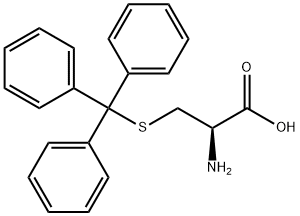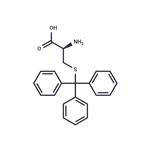Description
S-Trityl-cysteine (2799-07-7) is a cell permeable inhibitor of mitotic kinesin Eg5 (IC50 for inhibition of basal ATPase activity = 1 μM; IC50 for inhibition of microtubule-activated ATPase activity = 140 nM). Mean growth concentration (GI50) of 1.31 μM for a panel of 60 different tumor cell lines.
Chemical Properties
almost white to light yellow granular powder
Uses
(+)-
S-Trityl-L-cysteine, a non-natural, sulfur-containing amino acid is commonly used as a reagent in solution phase peptide synthesis (SPPS). It is also used as a metal-binding agent to synthesize substituted ferrocenoyl peptide conjugates using HBTU peptide coupling reagent for the cation-sensing applications solution via peptide-metal interactions.
Uses
A protected cysteine for peptide synthesis. S-Trityl-L-cysteine (STLC) is a tight-binding inhibitor of Eg5 that prevents mitotic progression. It has proven antitumor activity as shown in the NCI 60 tumor cell line screen.
Definition
ChEBI: (2R)-2-amino-3-[(triphenylmethyl)thio]propanoic acid is a benzenoid aromatic compound.
reaction suitability
reaction type: solution phase peptide synthesis
Biological Activity
Potent, cell-permeable, selective inhibitor of mitotic kinesin Eg5, a protein required for establishing and maintaining a bipolar spindle. Inhibits basal ATPase activity (IC 50 = 1 mM) and microtubule-activated ATPase activity of Eg5 (IC 50 = 140 nM). Induces mitotic arrest in HeLa cells with an IC 50 of 700 nM. Displays antitumor activity.
References
1) DeBonis et al. (2004) In vitro screening for inhibitors of the human mitotic kinesin Eg5 with antimitotic and antitumour activities; Mol. Cancer Ther. 3 1079
2) Brier et al. (2004) Identification of the protein binding region of S-trityl-L-cysteine, a new potent inhibitor of mitotic kinesin Eg5; Biochemistry 43 13072
3) Skoufias et al. (2006) S-trityl-l-cysteine is a reversible, tight-binding inhibitor of the human kinesin eg5 that specifically blocks mitotic progression; J. Biol. Chem., 281 17559




